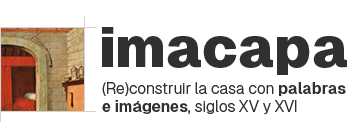
The goal is to provide an illustrated glossary-dictionary that encompasses the architecture of Christian, Moorish, Jewish and converso dwellings, as well as all the belongings they contained. This terminological instrument takes into account the political and cultural realities that came together at the time in Spain: the end of Al-Andalus; the confluence of Mudejar and Moorish communities together with old Christians; as well as the conquest of America and the coexistence of medieval architectural traditions with new ideas.
Certain meticulous inventories indicate the location of objects, just as some comprehensive cadastral surveys use a rich and varied terminology to describe room structure, distribution, as well as the interior architecture and building materials. But the meaning of some of those objects and house elements has been lost. Recovering their meaning will make it possible to reconstruct certain spaces using digital tools, performing a colorimetry recovery from the fabrics of some houses and their furnishings. The reconstructions will create the sensation of visiting a house, wandering through the physical spaces, and observing the objects in the kitchen and pantry, the rooms, the utensils for serving, lighting, heating, or praying, the beds and linen, and even the decorative elements hanging on the walls.
The images of the time show how certain items were assigned to men or women, forging stereotypes that do not always correspond to documentary reality. The meaning of this assigning within the household has not been rigorously studied to date. At the same time, as we analyse the words and images, we will associate the gender with which the room or object is usually identified. In this way, we will be able to recognise and reconstruct the role played by the different domestic group members in the material configuration of the experiential space.
Our interest in building knowledge about these Hispanic houses requires delving into the Christian, Moorish, Jewish and converso environments. It is essential to build a deeper understanding of the respective emotional communities that are reflected in the words and material culture of their homes. Again, the documentation describes Moorish style objects, Castilian items, as well as elements of different origins and cultural customs. Moreover, collecting the data of a home’s inhabitants, whether they are Moors, or new Christians, for example, helps us to grasp the atmosphere created in that interior, and the possible differences or similarities.
To these two dimensions we must add a third relating to the house as a container and generator of emotions, a subject that was studied in the previous project (VESCASEM). A wide range of items express the religious and devotional practice unfolding in homes: from the religious experience and feeling transmitted by the liturgical objects of wealthy families – who had an oratory –, to the small images, relics or humble rosaries transmitted from mothers to daughters. On other occasions, houses embody a distinctive lineage framework where artistic representations, weapons and trophies form a discourse of nobility and social superiority. The texts and documents also refer to private emotions that are essential for extended families to live together, including people in a position of slavery. Examples include affection and care, material culture, and terms related to upbringing and childhood, treatment of illness, the preparation of medicinal and hygiene products, etc. or the raw materials, recipes and objects used in the kitchen, perpetuating traditional uses proper to each emotional community. In this sense, the emotion perception dimension includes the elaboration of a sensory map of the house based on a digital tool.